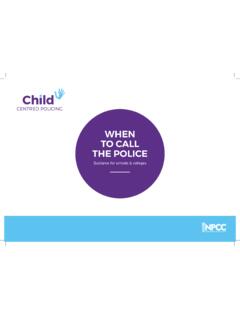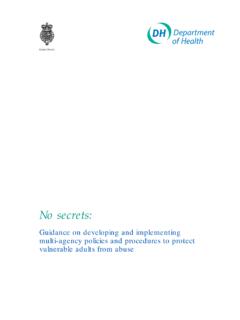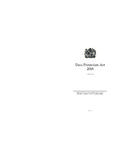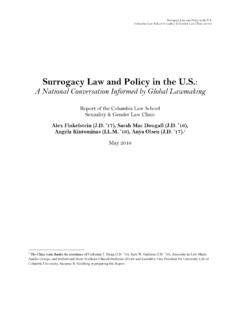Transcription of Safeguarding and Child Protection Policy
1 1 Safeguarding and Child Protection Policy Introduction Safeguarding is the responsibility that an organisation has to ensure that their employees and volunteers, partners, vendors, operations and programmes do no harm to children, young people or vulnerable adults1 (together referred to as vulnerable people under this Policy ); that they do not expose them to the risk of discrimination, neglect, harm and abuse; and that any concerns the organisation has about the safety of vulnerable people within the communities in which they work, are dealt with and reported to the appropriate authorities. It is also the responsibility that the organisation has for protecting its employees and volunteers when they are vulnerable, for example, when ill or at risk of harm or abuse.
2 Child Protection is a central part of but not separate to Safeguarding . It is the process of protecting individual children identified as either suffering or at risk of significant harm as a result of abuse or programme of work. It also includes measures and structures designed to prevent and respond to abuse. Over recent years, there has been increasing recognition of the way in which children, young people and vulnerable adults can be at risk of discrimination, neglect, abuse and exploitation by those who are in positions of trust and power over them, including through international development activities. As a consequence, there has been a significant increase in the efforts made by development organisations to ensure that no harm results from the contact their employees, volunteers and other representatives have with their target populations or communities.
3 Through their work, VSO employees, employees of partner organisations and volunteers may engage with young people and vulnerable adults either directly or indirectly. VSO recognises it has an obligation to put in place all reasonable Safeguarding measures to ensure, as far as possible, the safety and Protection of children, young people and vulnerable adults, including those with whom we work and those in the communities where VSO work is undertaken. Purpose The purpose of this Policy and associated procedures is to provide clarity to ALL on how they should engage with children, young people and vulnerable adults when working for, on behalf of, or in partnership with VSO. It is also to help us make sure that employees, volunteers and other representatives are protected.
4 It is intended to help us to have a common understanding of Safeguarding issues, develop good practice across the diverse and complex areas in which we operate and thereby increase accountability in this crucial aspect of our work. This Policy constitutes VSO s global Policy . Whilst it is recognised that local legislation may vary from country to country, this Policy identifies our minimum standards and may exceed the requirements of local legislation. Any breach of this Policy will be treated as a disciplinary matter, which may result in immediate termination of employment or contract, withdrawal of volunteer status, and reporting to the police, relevant regulatory authority or other body.
5 1 See section on definitions below 2 Definitions Abuse - a violation of an individual s human and civil rights by any other person or persons. It can take the form of physical, psychological, financial or sexual abuse, neglect or negligent treatment or commercial or other exploitation, resulting in actual or potential harm to the health, survival, development or dignity of a Child , young person or vulnerable adult. Abuse can be a single act or repeated acts and can be unintentional or deliberate. Abuse often involves criminal acts. Discriminatory abuse abuse motivated by a vulnerable person s age, race, nationality, sex, sexual orientation, disability, or other personal characteristic.
6 Financial or material abuse - including theft, fraud, exploitation, pressure in connection with wills, property or inheritance or financial transactions, or the misuse or misappropriation of property, possessions or benefits. Neglect - the persistent failure to meet a vulnerable person s basic physical and/or psychological needs, likely to result in the serious impairment of his/her health or development. Examples include failure to provide adequate food, clothing and shelter, failure to protect them from physical or psychological harm or danger; failure to ensure adequate supervision (including the use of inadequate care-givers); or failure to ensure access to appropriate medical care or treatment.
7 It may also include neglect of, or unresponsiveness to, a vulnerable person s basic emotional needs. Physical abuse includes hitting, shaking, throwing, poisoning, burning or scalding, drowning, suffocating or otherwise causing physical harm, misuse of medication, restraint, or inappropriate sanctions. Psychological abuse - includes emotional abuse, threats of harm or abandonment, deprivation of contact, humiliation, blaming, controlling, intimidation, coercion, harassment, verbal abuse, isolation or withdrawal from services or supportive networks. Examples include not giving a vulnerable person opportunities to express their views, deliberately silencing them or making fun of what they say or how they communicate.
8 It may feature age or developmentally inappropriate expectations being imposed on a vulnerable person, which may include interactions that are beyond a vulnerable person s developmental capability. It may involve serious bullying (including cyber bullying), or the exploitation or corruption of a vulnerable person. Sexual abuse - involves forcing, enticing or coercing someone to take part in sexual activities, whether or not the vulnerable person is aware of what is happening. The activities may involve physical contact, including assault by penetration (for example, rape or oral sex) or non-penetrative acts such as masturbation, kissing, rubbing and touching outside of clothing. They may also include non-contact activities, such as involving a vulnerable person in looking at, or in the production of, sexual images, watching sexual activities, encouraging children to behave in sexually inappropriate ways, or grooming a Child in preparation for abuse (including via the internet).
9 Sexual abuse can be carried out by adults or other children. Child VSO regards a Child as anyone under the age of 18 years, irrespective of the age of majority in the country in which the Child lives or in their home country. It is widely recognised that children are generally more vulnerable to abuse and exploitation due to factors such as age, gender, social and economic status, developmental stage, and dependence on others. Vulnerable person/people for the purposes of this Policy this is an umbrella term which covers children, young people and vulnerable adults. 3 Vulnerable adult - a person, 18 years and above, who by reason of disability, age, gender, social and economic status, or illness, the context they are in, may be unable to take care of or to protect him or herself against abuse, harm or exploitation.
10 Youth or young people - individuals aged 15 to 25 (15 to 35 in some countries) VSO recognises that this group spans the categories of children and adults but regards young people as having particular Safeguarding needs and requiring distinct consideration aside from younger children and older adults. Scope This Policy is mandatory for all VSO employees worldwide. For the purposes of this Policy , employee is defined as anyone who works for or on behalf of VSO, either in a paid or unpaid capacity. This therefore includes directly employed staff, trustees, contractors, employees and volunteers of sub contractors, agency workers, consultants, volunteers, interns and all visitors to VSO work programmes and offices.





